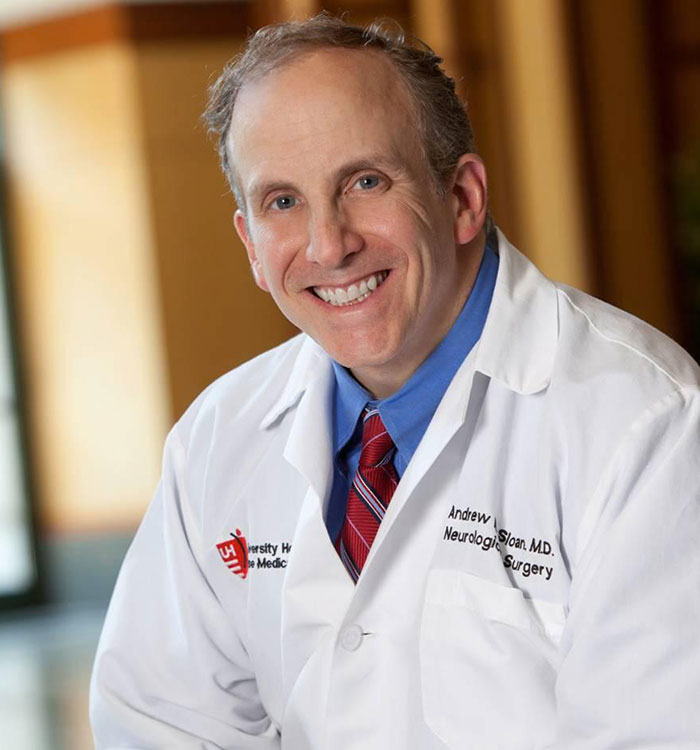Physician Spotlight: Andrew E. Sloan, MD
February 10, 2020
Neurosurgeon advances brain cancer research, surgical techniques
 Andrew E. Sloan, MD, FAANS, FACS
Andrew E. Sloan, MD, FAANS, FACSThroughout his career, Andrew E. Sloan, MD, FAANS, FACS, has had an interest in neuroscience and cancer biology and a desire to make a difference. For nearly 30 years — 13 of them at University Hospitals — the neurosurgeon has excelled by combining all three.
Dr. Sloan focuses most of his clinical practice and research on brain and spinal cord tumors. Many patients with malignant tumors survive less than a year. However, about half of all brain tumors are curable with surgery, chemotherapy, radiation or a combination of these.
By advancing brain cancer research and surgical techniques, Dr. Sloan hopes to help people suffering from these conditions live as many good years as possible.
LEARNING FROM THE BEST
When Dr. Sloan was a teen, two of his family members died from cancer, which made a big impact on his career choice. “I was a scientifically oriented kid, so I said to myself, ‘Maybe I can help prevent this from happening to someone else,’" he says.
To fulfill his goal, Dr. Sloan learned from the best. He earned his bachelor’s degree from Yale University and his medical degree from Harvard University. He completed a general surgery internship and a neurological surgery residency at UCLA's David Geffen School of Medicine. A neurosurgical oncology fellowship at University of Texas MD Anderson Cancer Center followed.
“Practicing at MD Anderson gave me the model for clinician-scientist,” he says. “I saw how I could really make a difference for patients with cancer. It’s considered one of the top institutions for brain cancer treatment, so I’m proud to have trained there.”
After faculty positions at University of South Florida H. Lee Moffitt Cancer Center and Research Institute in Tampa, Florida, and Wayne State University School of Medicine-Karmanos Cancer Institute in Detroit, Michigan, Dr. Sloan joined UH. He directs the Brain Tumor & Neuro-Oncology Center as well as the Center of Excellence in Translational at University Hospitals Seidman Cancer Center and University Hospitals Neurological Institute. Dr. Sloan holds joint appointments in pathology and the Center for Translational Neuroscience at Case Western Reserve University School of Medicine, where he also serves as professor and Vice Chairman of the Department of Neurosurgery.
ADVANCING BRAIN TUMOR RESEARCH
While his titles and honors — “Top Doctors,” “Best Surgeons,” “Maheley Award” — are impressive, Dr. Sloan’s research into glioblastoma is what sets him apart.
Dr. Sloan leads a multi-institutional, National Institutes of Health-funded clinical study using genetically engineered hematopoietic stem cells to protect the bone marrow when giving high-dose chemotherapy for newly diagnosed glioblastoma (GBM), the most malignant brain tumor known. Since the bone marrow is the primary site of toxicity-related chemotherapy for GBM, this stem cell gene therapy allows patients to tolerate much higher doses of chemotherapy than normal.
Preliminary results from a Phase I trial at UH, based on the scientific work of Stan Gerson, MD, Director of the Case Comprehensive Cancer Center at the School of Medicine, demonstrated patients survived more than threefold longer than expected. The trial, which is expected to open at UH and the National Cancer Institute in the second quarter of 2020, will expand the study to Phase II.
Dr. Sloan also serves as principal investigator at University Hospitals Cleveland Medical Center for the Phase II clinical trial for oncolytic polio/rhinovirus recombinant (PVSRIPO), a genetically modified polio virus used to treat recurrent GBM using convection-enhanced delivery. Patients with recurrent GBM typically live six months or less, but in the Phase I study, published in the New England Journal of Medicine and publicized on the television news program “60 Minutes,” 21 percent of participants lived 24 to 36 months.1 These patients are expected to live up to six years.
“Tumor vaccines, other types of immunotherapies and emerging concepts in gene therapy are all very exciting right now,” Dr. Sloan says. “We’re seeing patients with malignant gliomas live six years after treatment. We’ve never seen that before.”
MOVING THE NEEDLE FORWARD
Although he has 200 scientific publications to his credit, it’s the work of UH Neurological Institute as a whole that makes Dr. Sloan excited to come to work each day.
“We’re moving the needle in brain and spine cancer treatment,” he says. “We’re helping to improve the standard of care. I see a lot of good things on the horizon.”
Those positive contributions extend throughout Northeast Ohio, from large hospitals to rural clinics. “We collaborate with a lot of doctors throughout the community,” he says. “We give second opinions routinely. If patients in rural areas need care but want to stay close to home, they can come to us. We can provide the specialty care while they continue to receive routine care close to home.”
To refer a patient to Dr. Sloan, call 216-553-1778.
References
1. Desjardins A, Gromeier M, Herndon JE 2nd, et al. Recurrent Glioblastoma Treated with Recombinant Poliovirus. N Engl J Med. 2018;379(2):150–161. doi:10.1056/NEJMoa1716435. Accessed at: https://www.ncbi.nlm.nih.gov/pmc/articles/PMC6065102/


